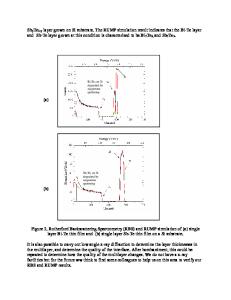Properties of Hydrogenated Amorphous Silicon-Germanium Alloys Deposited by Dual Target Reactive Magnetron Sputtering
- PDF / 207,221 Bytes
- 6 Pages / 432 x 648 pts Page_size
- 22 Downloads / 383 Views
Properties of Hydrogenated Amorphous Silicon-Germanium Alloys Deposited by Dual Target Reactive Magnetron Sputtering Samuel J. Levang and James R. Doyle Department of Physics and Astronomy, Macalester College, St. Paul, MN 55105 U.S.A. ABSTRACT Hydrogenated amorphous silicon-germanium alloy thin films (a-Si1-xGex:H) were deposited using reactive magnetron sputtering. Dual targets of silicon and germanium were sputtered in an argon + hydrogen atmosphere using rf excitation. Films with x = 0.4 were deposited as a function of substrate temperature and hydrogen partial pressure, and were evaluated by dark and photoconductivity, infrared absorption, and optical transmission. Photosensitivity reached a maximum value of about 5000 between 150 and 200 °C. Using the stretching modes in the region of 2000 cm-1, the hydrogen bonding was characterized in terms of the preferential attachment ratio (PA), which represents the ratio of H bonded to silicon to that bonded to germanium. The PA shows a systematic increase with increasing temperature, independent of hydrogen partial pressure. The interplay between thermodynamic and kinetics effects in determining PA and film quality will be discussed. INTRODUCTION Hydrogenated amorphous silicon-germanium alloys (a-Si1-xGex:H) are useful mid-gap absorber layers in thin-film solar cells. In particular the silicon to germanium ratio can be varied to optimize the bandgap for use in tandem solar cells [1]. For the middle cell, films with 40-50% Ge giving bandgaps in the range of 1.4 to 1.6 eV are most useful. However, at these compositions film opto-electrical properties degrade compared to unalloyed hydrogenated amorphous silicon, thereby reducing the overall efficiency of the solar cell. It has been proposed that the inferior electrical properties of the alloy films compared to the unalloyed amorphous silicon films is due to the preferential attachment (PA) of H to Si compared Ge during film growth. PA is defined as PA = (CSi-H/CGe-H)/ (CSi/CGe)
(1)
The cause of PA has been attributed to the stronger Si-H bond compared to the Ge-H bond, resulting in incomplete passivation of Ge dangling bonds and therefore in a higher defect density associated with incorporated Ge. The PA effect has been extensively studied in plasma enhanced chemical vapor deposition (PECVD) [2] as well as hot wire chemical vapor deposition (HWCVD) [3]. In these deposition methods, the film hydrogen content is determined primarily by the deposition temperature, as the hydrogen supply is difficult to control independently of the Si and Ge flux. In contrast, deposition by reactive magnetron sputtering allows more
301
independent control over the hydrogen supply to the films, and substrate temperature and hydrogen supply effects can be separated to a much larger extent. In this study, we have produced reactive magnetron sputtered films with bandgaps of 1.41.6 eV over a wide range of deposition temperatures and hydrogen partial pressures. Our best films showed good photoconductivity and photosensitivity comparable to PEC
Data Loading...










